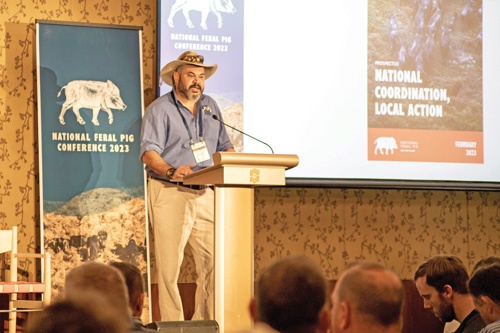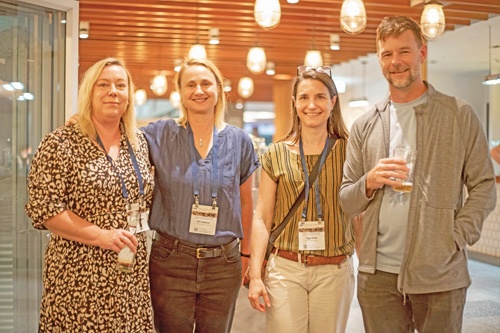ABOVE: Mark Hogno NFPAP Indigenous Advisory Panel chair and Carpentaria Land Council Aboriginal Corporation, Dr Justin Perry NFPAP Scientific Advisory Panel chair and NAILSMA, Dr Heather Channon and Ricky Archer NFPAP IC chair and NAILSMA.
Coordinated impact-driven feral pig management by land managers working together was the key message driven home at the National Feral Pig Conference 2023.
Australia’s first feral pig-specific conference was held in Cairns on June 20-21.
The National Feral Pig Conference aimed to provide land managers, agricultural sectors, community groups, jurisdictions, Indigenous organisations, natural resource management bodies, research agencies and other stakeholders with the opportunity to come together to:
- Share benefits from working together in coordinated groups
- Describe how integrated best practice management is being applied to reduce damage being caused by feral pig populations
- Understand how different monitoring approaches are being used to measure feral pig impacts
- Discuss how new insights and technologies can be used to optimise feral pig management.

NFPAP Implementation Committee chair and North Australian Indigenous Land and Sea Management Alliance chief executive officer Ricky Archer.
It was a truly national event, with a total of 150 delegates from all states and territories attending in person.
An additional 50 delegates attended virtually.
During the conference’s opening address, Minister Watt announced that the National Feral Pig Management Coordinator program had been extended for an additional two years – until June 30, 2025.
This was very welcomed and will enable continued focus on delivering the National Feral Pig Action Plan and supporting communities with reducing feral pig populations and their impacts through coordinated and collaborative control programs.
With the conference theme of ‘Effective feral pig management: adaptive and collaborative action’, a wide breadth of topics was covered.
Common messages from the conference were:
- We cannot manage what we don’t measure – more data was needed to inform feral pig management strategies and their outcomes
- Longer term resourcing of feral pig programs was required to reduce feral pig populations by 70 percent and subsequently maintain lowered numbers
- Having a local coordinator helped to keep feral pig programs on track and keep stakeholders engaged and motivated
- Management programs needed to be adaptive and data driven with a focus on impact reduction to provide effective feral pig control
- Coordinated community led feral pig programs were vital to reduce impacts by implementing on-ground pressure to feral pig populations
- A large suite of control methods needed to be available and utilised in appropriate combinations to efficiently reduce feral pig populations
- Stakeholders from multiple tenures, industries and backgrounds needed to all work and communicate together as feral pigs don’t understand boundaries or jurisdictions.

Michael Leane from Riverina Local Land Services NSW, David Coolwell from Gunditj Mirring Traditional Owners Aboriginal Corporation, Dr Heather Channon, Aaron Morgan from GMTOAC and Suzie Holbery representing Riverina Local Land Services NSW.
A selection of the presentations are summarised below.
Dr Kurt VerCauteren from USDA – our key invited speaker – provided insights into the US National Feral Swine Damage Management Program and how it could be improved.
It was clear to attendees that there were many similarities and challenges for Australian and US land managers dealing with feral pigs and their impacts.
The US program aimed to protect agricultural and natural resources, property, animal health, and human health and safety by managing feral swine damage.
More information on the program can be found at aphis.usda.gov/aphis/ourfocus/wildlifedamage/operational-activities/feral-swine
The Feral Swine Eradication and Control Pilot Program started in 2018 with a budget of $A112.34 million over five years.
This program aimed to reduce feral pig numbers to minimise damage in those US states where populations are large and widely distributed – including California and those in the southeast – and eliminate them in states where populations were low or newly emerging.
For the on-ground management program, aerial culling, ground shooting and trapping were the key methods used, with poison baiting not approved for use in the US.
Pre and post-control monitoring of populations was being done, but this was still a work in progress.

Shalan Scholfield from the Department of Agriculture, Fisheries and Forestry, Kim Stephan of Cape York Water Partnership, Dr Tiggy Grillo from Wildlife Health Australia and Dr Justin Perry from NAILSMA.
Different technologies – including field camera networks to estimate populations and radiotelemetry for movement tracking fitted to drones – were being used.
From a disease-surveillance perspective, more than 6000 samples were collected annually and tested for classical swine fever, pseudorabies and swine brucellosis.
In 2021, 21.5 percent of samples were positive for pseudorabies and 14.5 percent positive for swine brucellosis.
Targeted surveillance for African swine fever, CSF and foot and mouth disease was being undertaken on feral pigs in selected counties in Florida, Georgia, Louisiana and Texas.
Kurt emphasised the need to secure long-term funding – even with current budgets.
Additionally, governmental support, legislative action, public support and coordinated effort between land managers were also essential.
Dr Richard Bradhurst from the Centre of Excellence for Biosecurity Risk Analysis at the University of Melbourne discussed how the Australian Animal Disease Spread Model had been developed to simulate the potential spread and control of ASF within and between feral and domestic pig populations.
Richard explained how the AADIS could help explore the potential spread and control of emergency diseases, and the likelihood of spill over back and forth between domestic and feral populations.
The inclusion of feral pig population distribution and abundance data into other emergency disease models was being considered.
For this, credible estimates of feral pig distribution and abundance, and information to better understand regional and seasonal influences on feral pig contact rates with livestock was needed.
Bec Gray from NSW Local Land Services discussed the different management and monitoring approaches being used across NSW as part of a state-wide foot and mouth disease prevention and preparedness program.

Bec Gray from NSW Local Land Services, Darren Marshall of Southern Queensland Landscapes, Dr Andrew Bengsen from NSW Department of Primary Industries and Lachlan Marshall of Southern Queensland Landscapes.
Across NSW, 11 Local Land Services regions planned – and were completing – coordinated, integrated and broadscale cloven-hoofed vertebrate pest animal control programs within intensive pest control zones.
These zones were defined by a 10km radius from a theoretical infected premise.
Pre and post-control monitoring had been conducted using various monitoring methodologies, including aerial visual and aerial thermal techniques, and thermal drones.
Control efforts used across these zones in different regions were not the same – reflecting different landscapes, habitats and feral pig densities – ranging from targeted on-ground control campaigns of baiting, trapping and shooting through to intensive and frequent aerial control programs, and combinations of both.
Excitingly, the analysis of these different programs will provide much needed data and inform best practice recommendations for vertebrate pest animal population management.
These findings will also contribute to filling knowledge gaps including:
- Control technique effectiveness
- Effort required for population reduction
- Home range sizes
- Vertebrate pest re-invasion timeframes
- Organisational capacity to respond to an EAD outbreak.
The program concluded June 30, 2023, with findings to be reported in coming months.
PhD candidate from Melbourne Veterinary School at the University of Melbourne, Madalene Oberin was investigating the disease risks posed by feral pigs to domestic piggeries.
This project was being supported by Australian Pork Limited.
Preliminary findings highlighted the feral pig presence around piggeries could be greater than originally assumed, increasing the risks of disease spread.
This research will help to inform epidemiological models for emergency animal disease risks, such as ASF and FMD, and produce protocols for pork enterprises to self-implement camera trap surveillance – tailored to their specific feral pig risk – to improve on farm biosecurity.
To see the range of presentations and speakers involved in this conference, the program can be viewed at feralpigs.com.au/wp-content/uploads/2023/06/NFPC2023-Conference-Program-final.pdf
With the conference intentionally planned to ensure everyone had plenty of time to meet one another, share learnings and discuss key issues and challenges with feral pig management and monitoring, its objectives were met.

Dr Deane Smith from NSW Department of Primary Industries Vertebrate Pest Research Unit.
Sincere thanks are extended to the conference sponsors: Silver – Queensland Government and Australian Trapping Systems, Bronze – Animal Control Technologies Australia and Wildlife Health Australia and Exhibitors – PigBaitta and Gallagher.
New resources released to support land managers
NSW Local Land Services has recently released a series of feral pig management videos to support land managers dealing with feral pigs and their impacts via their YouTube channel.
These videos were developed to fill a gap in current resources and aimed at providing land managers with practical, timeless and factual information on the basics and best practice of feral pig management.
Note that these resources were prepared in line with NSW legislation.
The principles, tips and tricks on how to apply the different feral pig control tools, however, are relevant to most land managers dealing with feral pigs.
These videos cover the following topics:
- Seasonal behaviour in feral pigs – discussing key times to target control
- Feral pig control techniques
- Free feeding – what is it and why do it
- Setting up your baiting site – how to lay grain at a baiting site to maximise feral pig access
- Bait options for feral pig control – a summary of the toxins available in NSW
- Feral pig trap designs – an overview of different door designs for feral pig traps
- How to set your feral pig trap
- Types of grain for feral pig baiting and trapping
- Working with Local Land Services to control feral pigs – landholder perspective
- Controlling feral pigs in western NSW.
If you’d like to discuss any of these topics or require any further information, get in touch via heather.channon@feralpigs.com.au







